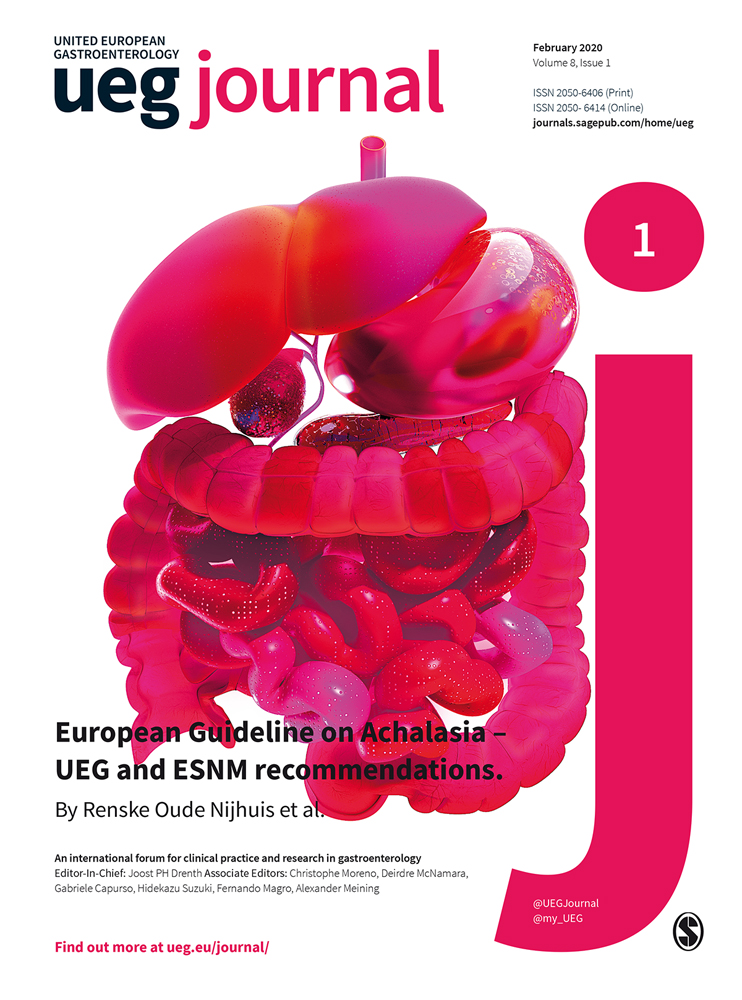Achalasia guideline: another step towards standardization of its management
In this issue of United European Gastroenterology Journal, experts from the United European Gastroenterology (UEG) and European Society of Neurogastroenterology and Motility (ESNM) have produced a comprehensive guideline on the diagnosis, treatment and follow-up of achalasia.1 The 30 recommendations are based on the critical assessment of the published literature by a team of experts in the field of clinical achalasia management.
With regard to the diagnosis of achalasia, the working group recommend to rely on oesophageal high-resolution manometry (HRM), with upper GI endoscopy to exclude other diseases. Timed barium swallow (instead of standard barium swallow), ie measurement of the height and width of the oesophageal barium column at 1, 2 and 5 minutes after the ingestion of a fixed volume (100 ml) of low-density barium suspension, is recommended only when HRM is not available. The more recently introduced technique of impedance planimetry (Endoflip®) is not recommended at that stage as the only mean of making the diagnosis of achalasia. Other imaging techniques such as CT scan and endoscopic ultrasound should be performed whenever at least 2 risk factors for malignant pseudo-achalasia are present (age greater than 55 years, recent onset of symptoms, significant weight loss and severe difficulty passing the lower oesophageal sphincter with the endoscope). Although all these recommendations are based on published evidence, one should insist on the fact that making the diagnosis of achalasia usually involves a sequential approach: first confronted to symptoms of dysphagia, an upper GI endoscopy should be performed to search for endoscopic lesions, and biopsies obtained to look for eosinophilic oesophagitis.2 HRM is then performed only if upper GI endoscopy and oesophageal biopsies are negative or suggestive of achalasia. A rapid drink challenge should be included in the HRM procedure to evaluate oesophageal clearance.3,4 Barium swallow is in fact often complementary to HRM, especially to evaluate the dilation of the oesophagus, which may be an important predictor of therapeutic success or failure. In that view, a chest CT scan may also provide significant information on the oesophageal dilation. Endoflip® is still in its infancy, expansive and used only in tertiary centers, at least in Europe: it is true that the diagnosis of achalasia cannot be made solely on impaired OGJ distensibility, but dynamic impedance planimetry can also provide information on peristalsis, and thus may be used in the near future to make the diagnosis of achalasia, as an alternative to HRM.5
With regard to the treatment of achalasia, medical treatment is not recommended, botulinum toxin injection should be left for patients unfit to other more invasive procedures, and other procedures (graded pneumatic dilations (PD), endoscopic myotomy or POEM, and laparoscopic Heller myotomy (LHM) with anti-reflux procedure) are thought to have comparable efficacy. The treatment decision should be based on patients’ age and characteristics, the HRM type of achalasia, patients’ preferences and centers’ expertise. PD is probably less effective in the rarest form of achalasia (type 3) that associates reduced OGJ distensibility and eosphageal spastic contractions, since those spastic contractions may persist after dilation of the OGJ. Endoscopic or surgical myotomies may be extended to include the spastic esophageal regions to obtain a more definite resolution of symptoms.6 The risk of developing GORD, which seems to be higher after POEM than after PD or LHM, must be also taken into account in the final therapeutic decision.7 It must be stressed, however, that published data on the subject are still unconvincing, mainly because of the difficulties to assess correctly GORD (and distinguish it from oesophageal stasis complications) in the context of achalasia.
Finally, the follow-up of achalasia after treatment should be based mainly on symptoms. In cases of persistent or recurrent symptoms after treatment (dysphagia, regurgitations, heartburn or chest pain), a complete work-up should be performed, in order to define the cause (incomplete myotomy, scarring, GORD, oesophageal dilation, functional symptoms …) and orient the management. HRM results are usually poorly correlated to symptoms after treatment, except may be for type 3 achalasia. GORD should be assessed with upper GI endoscopy to identify erosive oesophagitis, and esophageal pH monitoring in the absence of endoscopic lesions. Other tests should be included, such as timed barium swallow to measure oesophageal clearance, and possibly Endoflip® to accurately assess OGJ distensibility.8
In conclusion, the authors of this achalasia guideline are to be congratulated for their effort to standardize the management of this rare disease. There are still areas of uncertainties that commend collaborative studies to better understand the causes of the disease, and to optimize the diagnosis process, treatment and follow-up.
ORCID iD
Francois Mion https://orcid.org/0000-0002-2908-1591




